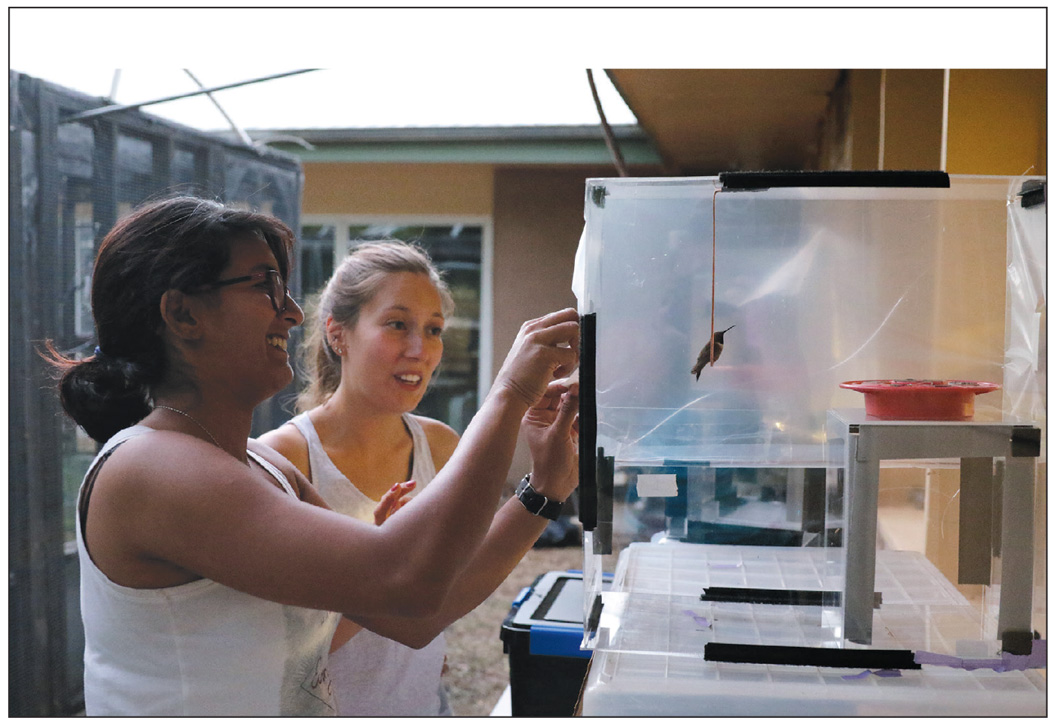How Hummingbirds Budget Nighttime Energy
By Katie L. Burke
These remarkable birds have the ability to drop their body temperatures, going into varying levels of torpor.
These remarkable birds have the ability to drop their body temperatures, going into varying levels of torpor.

Hummingbirds push the extremes of what is energetically possible in the animal world, zipping around with the fastest wingbeats of all birds, up to 80 beats per second in the smallest species. To keep up that pace, hummingbirds eat lots of nectar. If scaled to human size, their sugar intake would be equivalent to drinking a can of Coca-Cola every minute. Hummingbirds must get enough food to maintain their busy lives, without accruing fat stores that would weigh them down. Maintaining such a high metabolism is especially difficult at night. “With such a high energetic demand, if hummingbirds want to survive overnight, they either have to store up a lot of fat in the evening, which makes it harder to fly, or they have to save energy somehow,” says Anusha Shankar, a postdoctoral researcher at Cornell University.

Courtesy of Antonella Wilby (top) and Anusha Shankar, Isabelle Cisneros, Sarah Thompson, Don Powers (bottom).
In a paper published in January in the Journal of Experimental Biology, Shankar and her colleagues at George Fox University in Oregon, including her PhD advisors Don Powers and Catherine Graham, discovered that hummingbirds have remarkable energetic flexibility during their nightly rest. They can get much colder than they do when awake, toggling between different levels of torpor. Studying 33 hummingbirds among three species at the Southwestern Research Station in Arizona, the researchers used thermal imaging while the birds slept in the field to document their drops in surface temperature.
Past research had shown that hummingbirds drop into deep torpor at night, with the smallest species able to drop their body temperature to as low as 3 degrees Celsius. Such deep torpor—similar to a short bout of hibernation—conserves the most energy but also incapacitates the bird. Shankar and her team found that hummingbirds don’t always drop to such a low temperature unless necessary, instead staying in normal sleep (1 or 2 degrees Celsius below resting daytime temperature) or in shallow torpor (2 to 20 degrees Celsius below that baseline)—warm enough that they can still wake up quickly. Often, the hummingbirds used both deep and shallow torpor on the same night. Shankar’s team observed that all three species—Rivoli’s hummingbirds, blue-throated mountain-gems, and black-chinned hummingbirds—could drop into either state and spent 5 to 35 percent of the night in shallow torpor. (For more on these hummingbirds, see “Hummingbird and Bat Pollinators of the Chiricahuas,” November–December 2020.)
The ability to drop into either deep or shallow torpor (but not both) is known in a few other birds: Deep torpor—dropping more than 20 degrees Celsius below their normal body temperature—has been documented in nightjars and mousebirds, as well as hummingbirds; shallow torpor has been documented in dozens of bird species such as doves. Only hummingbirds have been observed to do both. Deep torpor brings fantastic energy savings—an average of 60 percent of their energy relative to their basal metabolic rates—but there are some hypothesized costs: susceptibility to predation, immune suppression, and sleep deprivation. Shankar notes that these trade-offs are not well understood, but that the hummingbirds’ flexibility allows them to reap some of the energy savings without incurring such steep costs. At the same time, deep torpor may have the added benefit of avoiding temperature-sensing predators such as snakes.
To test whether hummingbirds drop into shallow torpor as well as deep torpor, Shankar and her team built clear plexiglass boxes in which to keep individual hummingbirds at night, exposed to natural light and temperature (shown below). Each box had a thin plastic sheet over an open end, which they could lift with fishing line once the bird was asleep, so that the infrared camera could detect its surface temperature without interference. The team would capture hummingbirds just before sunset, feed them, and put them in the box to acclimate and fall asleep. Then, they’d film them with the infrared camera pointed at the bird’s eye to monitor temperature changes.

Antonella Wilby
Sleeping hummingbirds “are usually in this position with the bill up and the eyes closed. Sometimes they fluff or preen,” Shankar says. Once the bird drops into torpor, their breathing changes. In deep torpor, “very often they would not breathe for maybe 10 seconds, and then they’d take four quick deep breaths, then not breathe for 10 seconds again.”
“This study expands our understanding of how birds are using heterothermic [self-regulating body temperature] responses like torpor under natural conditions,” says Andrew McKechnie, who studies torpor in animals at the University of Pretoria in South Africa and who was not involved with this study. “The authors have done some very nice work prior to this on how individual birds use torpor and related responses to balance energy budgets. Their point here that some hummingbirds are not necessarily going into deep torpor is valid, and the reasons behind that are potentially very interesting.”
Shankar’s team found that the Rivoli’s hummingbird, one of the bigger hummingbirds they studied, weighing about 7.6 grams (a little more than three dimes), was the most flexible in terms of using shallow torpor, and was also the most easily disturbed. “There were times when the hummingbirds would face-plant against the plastic and fall asleep, and then we had to lift the plastic up without waking them, which was really hard,” Shankar says. “Once, we did disturb one that was in deep torpor, and it started to rewarm. But it couldn’t do anything for 20 to 30 minutes.” The smallest hummingbird in the study, the black-chinned hummingbird, which weighs 2.9 grams, mostly dropped into deep torpor. “There’s something to do with the capacity for storing fat, I think, that’s linked to which strategy they end up using,” Shankar says.
Hummingbirds have much more energetic flexibility, both at night and during the day, than Shankar imagined.
Shankar’s research so far has shown that hummingbirds have much more energetic flexibility, both at night and during the day, than she or most others imagined. “We think of hummingbirds as these crazy high-powered flying machines that are working all the time,” she says, “but they can be perching for 80 percent of their day or hovering for 80 percent of their day. That same flexibility carries through to the night in their ability to use torpor or not.”
Shankar is now studying what happens physiologically in hummingbirds while they are in torpor. “It’s surprising to me that no one has looked at gene expression in bird torpor,” Shankar says. “Each tissue has different levels of gene expression, and those genes are being turned off or on differently in these states of torpor versus normal sleep. A lot of people have looked at it in mammals. I have no idea what’s going on inside the hummingbird’s body.”
It’s possible many of the same genes are at play in torpor in mammals and birds, or that different genes have evolved independently. Studying hummingbirds will lead to a better understanding of thermoregulation across all vertebrates. Shankar says, “Hummingbirds can cool down to 3 degrees Celsius, get warm the next morning, and their hearts and livers can function normally. It’s an incredible ability.”
Click "American Scientist" to access home page
American Scientist Comments and Discussion
To discuss our articles or comment on them, please share them and tag American Scientist on social media platforms. Here are links to our profiles on Twitter, Facebook, and LinkedIn.
If we re-share your post, we will moderate comments/discussion following our comments policy.